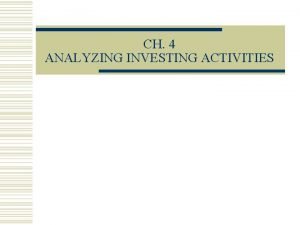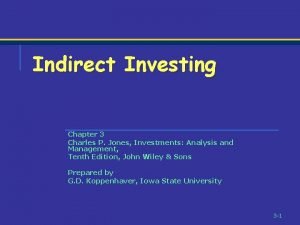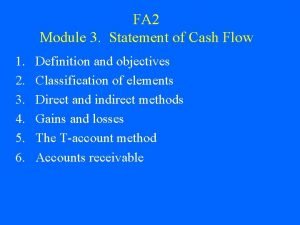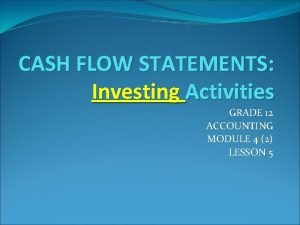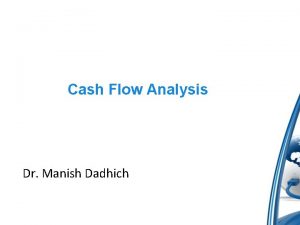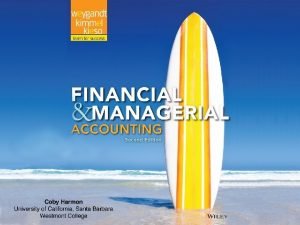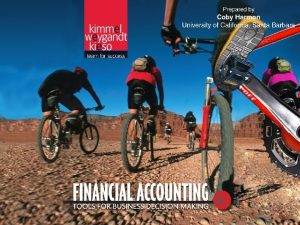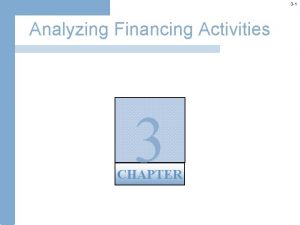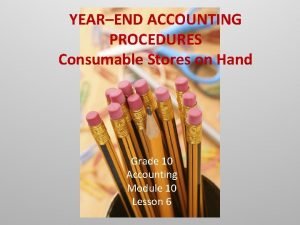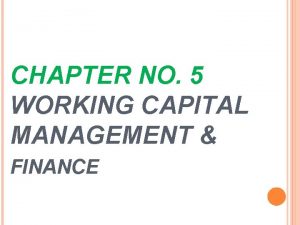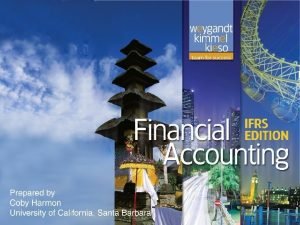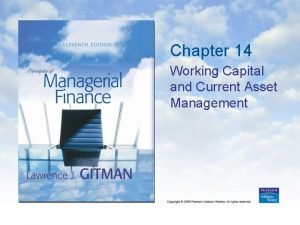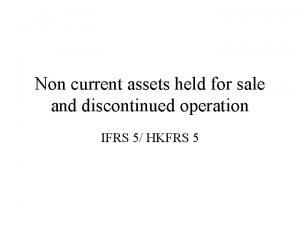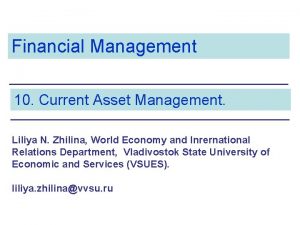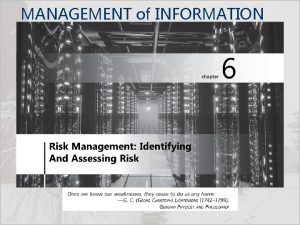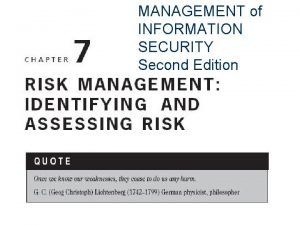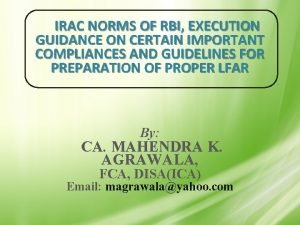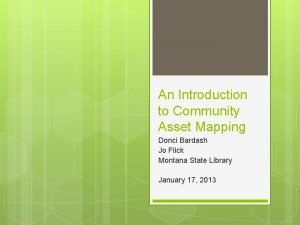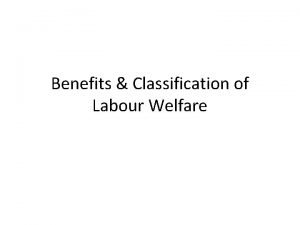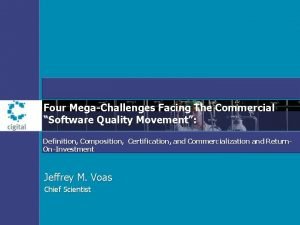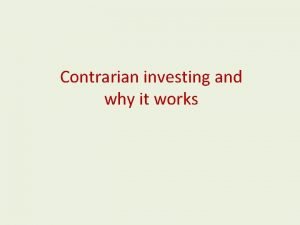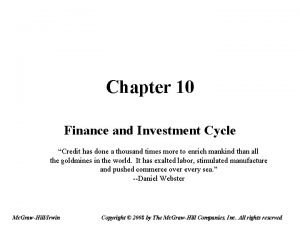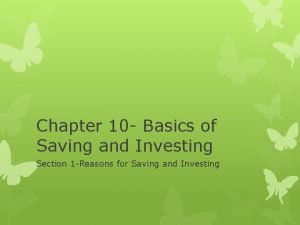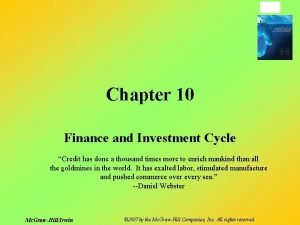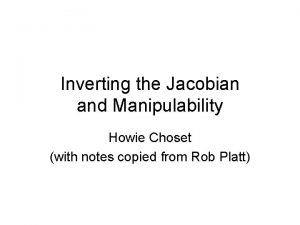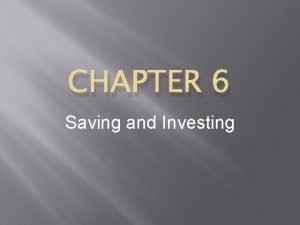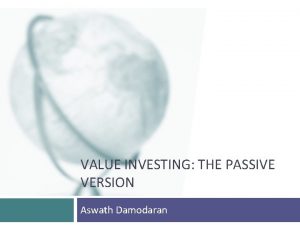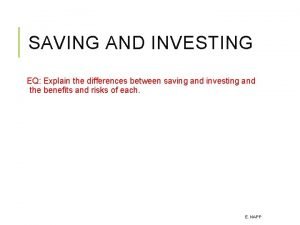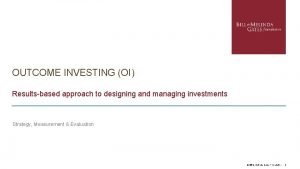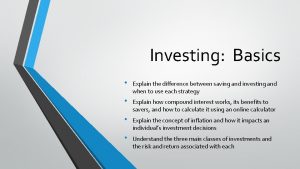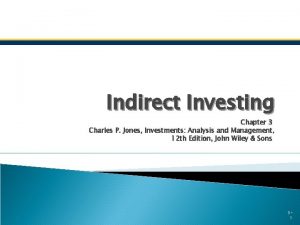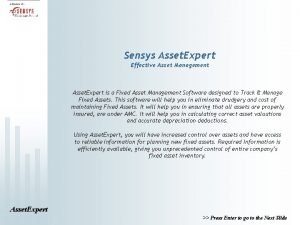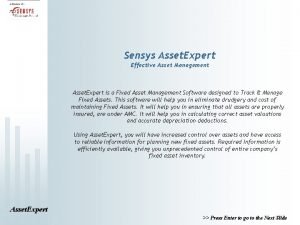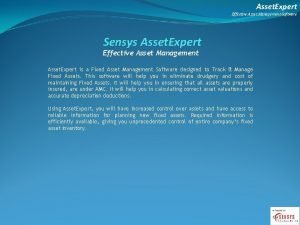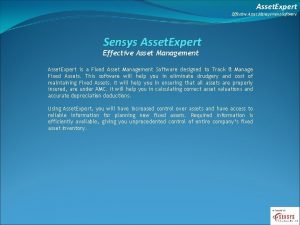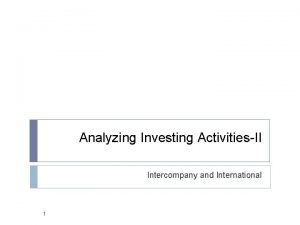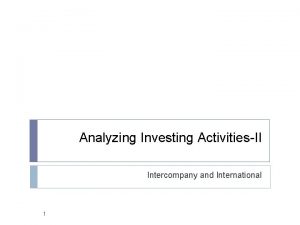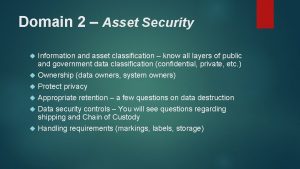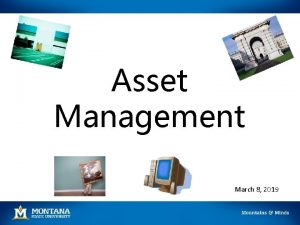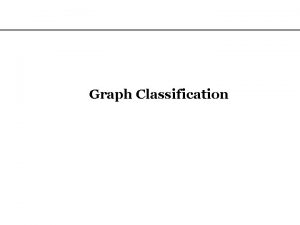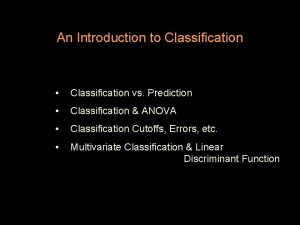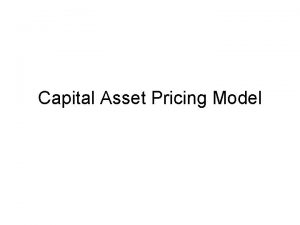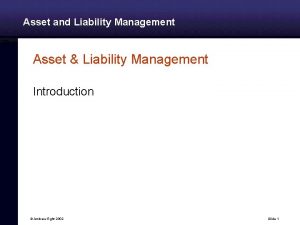Analyzing Investing Activities Current Asset Introduction Classification Current





















































































- Slides: 85

Analyzing Investing Activities .

Current Asset Introduction Classification Current (shortterm) Assets Resources or claims to resources that are expected to be sold, collected, or used within one year or the operating cycle, whichever is longer. Noncurrent (Long. Term) Assets Resources or claims to resources that are expected to yield benefits that extend beyond one year or the operating cycle, whichever is longer.

OPERATING CYCLE • An operating cycle is the amount of time from commitment of cash for purchases until the collection of cash resulting from sales of goods or services. • It is the process by which a company converts cash into short-term assets and back into cash as part of its ongoing operating activities.

Cash on hand 1 1 2 4 2 3 3 Services sold to customers Products sold to customers Cash paid for products 4 Customers pay for products Cash on hand Cash paid to employees Customers pay for services Operating Cycle

OPERATING CYCLE CONT…

Cash, Cash Equivalents and Liquidity Cash Currency, coins and amounts on deposit in bank accounts, checking accounts, and some savings accounts. Cash, the most liquid asset, includes currency available and funds on deposit. Cash equivalents are highly liquid, short-term investments that are (1) Readily convertible into cash (2) So near maturity that they have minimal risk of price changes due to interest rate movements. Liquidity provides flexibility to take advantage of changing market conditions and to react to strategic actions by competitors. Liquidity also relates to the ability of a company to meet its obligations as they mature.

Analysis of Cash and Cash Equivalents

Analysis of Cash and Cash Equivalents CONT… • As the graphic indicates, cash and cash equivalents as a percentage of total assets ranges from 2% (Target) to 22% (Dell). • These differences can result from a number of factors • Companies in a dynamic industry require increased liquidity to take advantage of opportunities or to react to a quickly changing competitive landscape. • The analyst will also look at the extent that cash equivalents are invested in equity securities, companies risk a reduction in liquidity should the market value of those investments decline. • Cash and cash equivalents are sometimes required to be maintained as compensating balances to support existing borrowing arrangements or as collateral for indebtedness.

ANALYZING RECEIVABLES • Analysis of receivables must recognize the possibility of error in judgment as to their ultimate collection. Collection Risk - Most provisions for uncollectible accounts are based on past experience, full information to assess collection risk for receivables is not usually included in financial statements. Analysis tools for investigating collection include: v Comparing competitors’ receivables as a percentage of sales with those of the company under analysis v Examining customer concentration—risk increases when receivables are concentrated in one or a few customers v Computing and investigating trends in the average collection period of receivables compared with customary credit terms for the industry v Determining the portion of receivables that are renewals of prior accounts or notes receivables

Authenticity of Receivables • The description of receivables in financial statements or notes is usually insufficient to provide reliable clues as to whether receivables are genuine, due, and enforceable. • One factor affecting authenticity is the right of merchandise return. Liberal return privileges can impair quality of receivables. • Receivables also are subject to various contingencies. Analysis can reveal whether contingencies impair the value of receivables. Accounts receivable: Accounts receivable are stated net after allowances for returns and doubtful accounts of $472, 000. Accounts receivable include approximately $4, 785, 000 for shipments made under a deferred payment plan whereby title to the merchandise is transferred to the dealer when shipped; however, the company retains a security interest in such merchandise until sold by the dealer. Payment to the Company is due from the dealer as the merchandise is sold at retail. The amount of receivables of this type shall at no time exceed $11 million under terms of the loan and security agreement. Receivables like these often entail more collection risk than receivables without contingencies.

Securitization of Receivables • • Analysis issue also arise when a company sells all or a portion of its receivables to a third party which finances the sale by selling bonds to the capital markets. The collection of those receivables provides the source for the yield on the bond. This practice is called securitization. Recourse refers to guarantee of collectability. Receivables can be sold with or without recourse to a buyer. Sale of receivables with recourse does not effectively transfer risk of ownership of receivables from the seller. Receivables can be kept off the balance sheet only when the company selling its receivables surrenders all control over the receivables to an independent buyer of sufficient financial strength. The securitization of receivables is often accomplished by establishing a special purpose entity (SPE). Securitization often involves lenders that package loans and sell them to investors, then use the freed-up capital to make new loans. Yet lenders often retain the riskiest piece of the loans because it is the hardest to sell—meaning they could still be on the hook if the loans go bad.

PREPAID EXPENSES • Prepaid expenses are advance payments for services or goods not yet received. Examples are advance payments for rent, insurance, utilities, and property taxes. Prepaid expenses usually are classified in current assets because they reflect services due that would otherwise require use of current assets.

INVENTORIES Definition – Goods held for sale as part of a company’s normal business operations Why scrutinize? Ø Major component of operating assets. Ø Directly affect determination of income.

INVENTORY COSTING Assigning costs to inventory affects both income and asset measurements. Ø How does it affect income? Cost of goods is deduction from income. Ø How does it affect assets? ending / closing inventory forms part of current assets.

Inventory equation Opening inventories + purchases – cost of goods sold = closing inventories The above equation highlights the flow of costs within the company. Balance sheet (cost of inventory) COGS Income statement

METHODS OF INVENTORY COSTING • FIFO – first in first out • LIFO – last in first out • AVERAGE COSTING – simple weighted average

Inventory costing Effects of Inventory costing on……. 1. Profitability 2. Balance sheet 3. Cash flows

Inventory costing – Effects on profitability • Each of the above methods will result in different COGS and ending inventories. This implies that each of the method will yield different net income and asset figures. • In periods of rising prices, FIFO produces higher gross profits than LIFO because lower cost inventories are matched against sales revenues at current market prices. This is referred to as FIFO’s phantom profits as the gross profit is actually a sum of two components; an economic profit and a holding gain.

Gross profit = economic profit + holding gains The economic profit = no. of units sold x (sales price – replacement cost) Holding gains = no. of units sold x (replacement cost – acquisition cost) Example: No of units sold = 30 Sales price = $800 Replacement cost = $600 Acquisition cost = $500 Gross profit = (30 x $800) – (30 x $500) = $9, 000 Economic profit = 30 x ($800 - 600) = $6, 000 Holding gains = 30 x ($600 -500) = $3000 Of the $9, 000 reported profit, $3, 000 relates to inflationary gains realized by the company on holding stocks it purchased some time ago at prices lower than current prices.

Inventory costing – Effects on balance sheet In periods of rising prices, LIFO reports closing inventories at prices that can be significantly lower than replacement cost. As a result the balance sheets of LIFO companies do not accurately represent the current investment it has in its inventories.

Inventory costing – Effects on cash flows • The increase in gross profit under FIFO results in higher pre-tax income and consequently higher tax liability. In periods of rising prices, companies can get caught in cash flow squeeze as they pay higher taxes and must replace the inventories sold at replacement costs higher than the original purchase cost. This can lead to liquidity problems.

Effects on cash flows……contd • One of the reasons usually cited for adoption of LIFO is the reduction of tax liability in period of rising prices. The IRS requires that company using LIFO inventory costing for tax purposes also use it for financial reporting.

Effects on cash flows……contd • Companies using LIFO costing method are required to disclose the amount at which inventories would have been had the company used FIFO costing method. The difference between the two is called LIFO reserve. Analyst can use this reserve to compute the amount by which cash flow has been affected both cumulatively and for current period by the use of LIFO.

OTHER ISSUES IN INVENTORY VALUATION

v FIFO represents inventory reported at the most recently acquired costs v Earlier cost layers do not differ with the current cost. v LIFO ending inventories are reported at much older costs that may be significantly lower or higher than the current costs. v LIFO Liquidation results in an increase in Gross profit that is similar to the effect of FIFO inventory costing in period of rising prices. v In periods of declining prices the reduction of inventory quantities can lead to decrease in reported Gross profits

Analytical Restatement of LIFO to FIFO v LIFO method during analysis of inventory requires no significant adjustment that needs to be carried out since cost of goods sold approximates current costs. v LIFO leaves inventories in the balance sheet understated. v LIFO also understated the Company’s debt paying ability v To counter the problems mentioned The following three adjustments are necessary: • Inventories=Reported LIFO inventory+ LIFO reserves • Increase differed tax payable by: (LIFO reserve x Tax rate) • Retained Earnings= Reported Retained Earnings+ [LIFO Reserve x(1 -Tax rate]

Restatement of FIFO to LIFO requires an assumption to be made that makes the process be prone to error. This is because FIFO profit has a holding gain at the beginning inventory multiplied by an inflation rate for the particular line of inventory that the firm carries. (r). This means that the cost of FIFO is understated by BI FIFO multiplied r this means to compute LIFO , COGs LIFO simply add BI FIFO X r to COGSFIFO R can be an index published by the government, or commodity index R=Change in LIFO reserve/ FIFO inventories from previous year-end Inventory Method Choice For companies choosing LIFO, the following characteristics are common: v v Greater expected tax savings. Larger inventory balances. Less tax loss carries forwards. Lower variability in inventory

v v v Balances. Less likelihood of inventory obsolescence. Larger in size. Less leveraged. Higher current ratios.

Cost of A Manufacturing Company Overhead costs which are usually the largest portion of production cost and difficult to measure since it has to be allocated to all products produced. The assumption usually made is that products that consume more resources should get high allocation. Analyst should look at effects of production level on profitability. Overhead is allocated to all units produced. The overheads are not expensed in the period in which they are included in the cost of inventories and remain on the balance sheet until the inventory are sold at which time they are reflected as cost of goods sold in the income statement. If an increase in production levels causes ending inventories to increase more of overhead costs, but also previous overhead costs that have been removed from inventories in the current year thus lowering the profits

Lower of Cost or Market Lower of cost or market general accepted principle of inventory valuation is lower of cost or market. Market is the current replacement cost either through purchases or reproduction. It must not be higher than Net Realizable Value reduced by profit margin. The principle of lower of cost or market can significantly affect periodic income and inventory value. This principle implies that if inventory cost goes down due to damage and price changes then it is written down to reflect this loss that is charged against revenue in the period in which it occurred.

LONG-TERM ASSETS

LONG-TERM ASSETS • Long-term (or non-current)assets are resources expected to benefit the company for periods beyond the current period. Major long-term assets include property, plant, equipment, intangibles, investments, and deferred charges. INTRODUCTION TO LONG-TERM ASSETS • Long-term assets are resources that are used to generate operating revenues (or reduce operating costs) for more than one period.

Common Types of Long-Term Asset • Tangible fixed assets such as property, plant, and equipment. • Intangible assets such as patents, trademarks, copyrights, and goodwill. Accounting for Long-Term Assets Capitalization, Allocation, and Impairment • The process of long-term asset accounting involves three distinct activities: capitalization, allocation, and impairment.

Capitalization Accounting for Long. Term Assets Impairment Allocation

Plant assets and Natural resources Property, plant, and equipment (or plant assets)are noncurrent tangible assets used in the manufacturing, merchandising, or service processes to generate revenues and cash flows for more than one period. Accordingly, these assets have expected useful lives. Valuing Plant Assets and Natural Resources This section describes the valuation of plant assets and natural resources. Valuing Property, Plant, and Equipment. The historical cost principle is applied when valuing property, plant, and equipment. Historical cost valuation implies a company initially records an asset at its purchase cost. This cost includes any expenses necessary to bring the asset to a usable or serviceable condition and location such as freight, installation, taxes, and set-up.

Valuing Property, Plant, and Equipment • All costs of acquisition and preparation are capitalized in the asset’s account balance. Historical cost method is primarily highly objectivity. • Historical cost valuation of plant assets, if consistently applied, usually does not yield serious distortions. • This section considers some special concerns that arise when valuing assets.

Valuing Natural Resources Natural resources, also called wasting assets, are rights to extract or consume natural resources. Examples are purchase rights to minerals, timber, natural gas, and petroleum. Companies report natural resources at historical cost plus costs of discovery, exploration, and development. Also, there often are substantial costs subsequent to discovery of natural resources that are capitalized on the balance sheet, and are expensed only when the resource is later removed, consumed, or sold. Companies allocate costs of natural resources over the total units of estimated reserves available. This allocation process is called depletion.

Depreciation A basic principle of income determination is that income benefiting from use of long term assets must bear a proportionate share of their costs. Depreciation is the allocation of the costs of plant and equipment (land is not depreciated) over their useful lives. Although added back in the statement of cash flows as a noncash expense, depreciation does not provide funds for replacement of an asset. This is a common misconception. Funding for capital expenditures is achieved through operating cash flow and financing activities.

Rate of depreciation The rate of depreciation depends on two factors: useful life and allocation method. Useful Life. The useful lives of assets vary greatly. Assumptions regarding useful lives of assets are based on economic conditions, engineering studies, experience, and information about an asset’s physical and productive properties. Physical deterioration is an important factor limiting useful life, and nearly all assets are subject to it. The frequency and quality of maintenance bear on physical deterioration. Maintenance can extend useful life but cannot prolong it indefinitely.

Rate of depreciation Another limiting factor is obsolescence, which impacts useful life through technological developments, consumption patterns, and economic forces. Ordinary obsolescence occurs when technological developments make an asset inefficient or uneconomical before its physical life is complete. ` Extraordinary obsolescence occurs when revolutionary changes occur or radical shifts in demand ensue. High-tech equipment is continually subject to rapid obsolescence.

Allocation method Depreciation varies significantly depending on the method chosen. We consider the two most common classes of methods: Straight-line and accelerated. Straight-line. The straight-line method of depreciation allocates the cost of an asset to its useful life on the basis of equal periodic charges

Straight line depreciation • The rationale for straight-line depreciation is the assumption that physical deterioration occurs uniformly over time. This assumption is likely more valid for fixed structures such as buildings than for machinery where utilization is a more important factor. Its major attribute is its simplicity. This accounts for its popularity. As the marginal graphic shows, straight-line depreciation is used by approximately 85% of publicly traded companies for financial reporting purposes (accelerated methods of depreciation are used for tax returns as we discuss below).

Demerits of straight line depreciation. • Straight-line depreciation implicitly assumes that depreciation in early years is identical to that in later years when the asset is likely less efficient and requires increased maintenance. • Another flaw with straight-line depreciation, is the resulting distortion in rate of return. The straight-line depreciation yields an increasing bias in the asset’s rate of return pattern over time. • While increasing maintenance costs can decrease income before depreciation, they do not negate the overall effect of an increasing return over time. Certainly, an increasing return on an aging asset is not reflective of most businesses.

Accelerated method. • Accelerated methods of depreciation allocate the cost of an asset to its useful life in a decreasing manner. Merits. • Use of these methods is encouraged by their acceptance in the Internal Revenue Code. Their appeal for tax purposes is the acceleration of cost allocation and the subsequent deferral of taxable income. The faster an asset is written off for tax purposes, the greater the tax deferral to future periods and the more funds immediately available for operations. The conceptual support for accelerated methods is the view that decreasing depreciation charges over time compensate for (1) increasing repair and maintenance costs, (2) decreasing revenues and operating efficiency, and (3) higher uncertainty of revenues in later years of aged assets (due to obsolescence).

Forms of accelerated depreciation • There exists two forms. The declining-balance method applies a constant rate to the declining asset balance (carrying value). In practice, an approximation to the exact rate of declining-charge depreciation is to use a multiple (often two times) of the straightline rate. For example, an asset with a 10 -year useful life is depreciated at a double declining- balance rate of 20%. • The sum-of-the-years’-digits method applies a decreasing fraction to asset cost less salvage value. For example, an asset depreciated over a five-year period is written off by applying a fraction whose denominator is the sum of the five years’ digits (1 -2 -3 -4 -5 -15) and whose numerator is the remaining life from the beginning of the period. This yields a fraction of • 5⁄15 for the first year, 4⁄15 for the second year, progressing to 1⁄15 in the fifth and final year.

Declining-balance methods. • Declining-balance methods do not violate this. When depreciation expense using the declining-balance method falls below the straight-line rate, it is common practice to use the straight-line rate for the remaining periods. • Special methods of depreciation are found in certain industries like steel and heavy machinery. The most common of these methods links depreciation charges to activity or intensity of asset use. For example, if a machine has a useful life of 10, 000 running hours, the depreciation charge varies with hours of running time rather than the period of time. It is important when using activity methods (also called unit-of production methods) that the estimate of useful life be periodically reviewed to remain valid under changing conditions.

Depletion. • Depletion is the allocation of the cost of natural resources on the basis of rate of extraction or production. • The difference between depreciation and depletion is that depreciation usually is an allocation of the cost of a productive asset over time, while depletion is an allocation of cost based on unit exploitation of natural resources like coal, oil, minerals, or timber. • Depletion depends on production—more production yields more depletion expense. Our analysis must be aware that, like depreciation, depletion can produce complications such as reliability, or lack thereof, of the estimate of recoverable resources. Companies must periodically review this estimate to ensure it reflects all information.

Impairment • We need to ask ourselves if accounting make any attempts to reflect the current value of the asset on the balance sheet. Current accounting does so, but on a conservative basis. • That is, when the depreciated amount of an asset is estimated to be higher than its current estimated value (often, its market value), then its amount on the balance sheet is written down to reflect its current value. Such a write-down (or write-off) is termed impairment.

Impairment • Current accounting rules for impairment of longlived assets are specified under SFAS 121 and its successor SFAS 144. Note • At present, accounting does not allow a write-up of an asset’s value to reflect its current market value. However, this is expected to change as standard setters eventually move toward a comprehensive model of fair value accounting.

Analyzing Plant Assets and Natural Resources • Valuation of plant assets and natural resources emphasizes objectivity of historical cost. • This may not be applied while assessing replacement values or in determining future need for operating assets. • Also, they are not comparable across different companies’ reports • This method is not particularly useful in measuring opportunity costs of disposal or in assessing alternative uses of funds. Further, in times of changing price levels, they represent a collection of expenditures reflecting different purchasing power.

Analyzing plant assets and natural resources. • Whereas write-up of plant assets to market is not acceptable accounting, conservatism permits a writedown if a permanent impairment in value occurs. A write-down relieves future periods of charges related to operating activities. • While realities of business dictate numerous uncertainties, including accounting estimation errors, our analysis demands scrutiny of such special charges. Accounting rules for impairments of long-term assets require companies to periodically review events or changes in circumstances for possible impairments

Continued • Nevertheless, companies can still defer recognition of impairments beyond the time when management first learns of them. In this case, subsequent write-downs can distort reported results. Under current rules, companies use a “recoverability test” to determine whether impairment exists. • That is, a company must estimate future net cash flows expected from the asset and its eventual disposition. If these expected net cash flows (undiscounted) are less than the asset’s carrying amount, it is impaired. The impairment loss is measured as the excess of the asset’s carrying value over fair value, where fair value is the market value or present value of expected future net cash flows.

Analyzing Depreciation and Depletion • Most companies use long-term productive assets in their operating activities and, in these cases, depreciation is usually a major expense. • Managers make decisions involving the depreciable base, useful life, and allocation method. These decisions can yield substantially different depreciation charges. Our analysis should include information on these factors both to effectively assess earnings and to compare analysis of companies’ earnings. • One focus of analysis is on any revisions of useful lives of assets. While such revisions can produce more reliable allocations of costs, our analysis must approach any revisions with concern, because such revisions are sometimes used to shift or smooth income across periods.

Analyzing depreciation and depletion • Challenges in analyzing depreciation and deprecation. • There is usually no disclosure on the relation between depreciation rates and the size of the asset pool, nor between the rate used and the allocation method. While use of the straight-line method enables us to approximate future depreciation, accelerated methods make this approximation less reliable unless we can obtain additional information often not disclosed. • Another challenge for our analysis arises from differences in allocation methods used for financial reporting and for tax purposes. Three common possibilities are/Limitations. • 1. Use of straight-line for both financial reporting and tax purposes. • 2. Use of straight-line for financial reporting and an accelerated method for tax. • The favorable tax effect resulting from higher tax depreciation is offset in financial reports with inter-period tax allocation.

Analyzing depreciation and depletion • 3. Use of an accelerated method for both financial reporting and tax. This yields higher depreciation in early years, which can be extended over many years with an expanding company. • Disclosures about the impact of these differing possibilities are not always adequate. Adequate disclosures include information on depreciation charges under the alternative allocations. If a company discloses deferred taxes arising from accelerated depreciation for tax, our analysis can approximate the added depreciation due to acceleration by dividing the deferred tax amount by the current tax rate.

continued • In spite of these limitations, our analysis should not ignore depreciation information, nor should it focus on income before depreciation. • Note, depreciation expense derives from cash spent in the past—it does not require any current cash outlay. For this reason, a few analysts refer to income before depreciation as cash flow. This is an unfortunate oversimplification because it omits many factors constituting cash flow. It is, at best, a poor estimate because it includes only selected inflows without considering a company’s commitment to outflows like plant replacement, investments, or dividend.

Continued • The quality of information in annual reports regarding allocation methods varies widely and is often less complete than disclosures in SEC filings. More detailed information typically includes the method or methods of depreciation and the range of useful lives for various asset categories. However, even this information is of limited usefulness. • It is difficult to infer much from allocation methods used without quantitative information on the extent of their use and the assets affected. • Basic information on ranges of useful lives and allocation methods contributes little to our. Our analysis must not make this mistake. One reason for this misconception is the absence of any current cash outflow.

Continued • Purchasing a machine with a five-year useful life is, in effect, a prepayment for five years of services. • For example, take a machine and assume a worker operates it for eight hours a day. If we contract with this worker for services over a five-year period and pay for them in advance, we would allocate this pay over five years of work. At the end of the first year, one-fifth of the pay is expensed and the remaining four-fifths of pay is an asset for a claim on future services. The similarity between the labor contract and the machine is apparent. • In Year 2 of the labor contract, there is no cash outlay, but there is no doubt about the reality of labor costs. Depreciation of machinery is no different.

Continued • Analyzing depreciation requires evaluation of its adequacy. • For this purpose we use measures such as the ratio of depreciation to total assets or the ratio of depreciation to other size-related factors. • In addition, there are several measures relating to plant asset age that are useful in comparing depreciation policies over time and across companies, including the following:

Continued • Average total life span: Gross plant and equipment assets/Current year depreciation expense. • Average age: Accumulated depreciation/Current year depreciation expense. • Average remaining life: Net plant and equipment assets/Current year depreciation expense. • These measures provide reasonable estimates for companies using straight-line depreciation but are less useful for companies using accelerated methods. Another measure often useful in our analysis is: • Average total life span: Average _ Average remaining life • Each of these measures can help us assess a company’s depreciation policies and decisions over time. Average of plant and equipment is useful in evaluating several factors including profit margins and future financing requirements. For example, capital intensive

Analyzing impairment Analyzing Impairments Three analysis issues arising with impairment are: • Evaluating the appropriateness of the amount of the impairment, • Evaluating the appropriateness of the timing of the impairment, • Analyzing the effect of the impairment on income. • Evaluating the appropriateness of the amount of impairment is the most difficult analysis task. • Here are some issues that an analyst can consider. i) First, identify the asset class is being written down or written off. Ii) Measure the percentage of the asset that is being written off. iii)Evaluate whether the write-off amount is appropriate for the asset class

Analyzing impairement. • crash, it is useful to compare the percentages of the writeoff with those taken by other companies in the industry. • Evaluating the timing of the impairment write-off is also important. It is important to note whether the company is taking timely write-offs or delaying taking write-offs. • Once again comparison with other companies in the industry can help. Also, one needs to note whether a company in bunching large write-offs in a single period as part of a “big bath” earnings management strategy. • Finally, dealing with the effects of write-offs on income is an important issue that an analyst needs to examine.

Capitalization • This is the process of deferring a cost that is incurred in the current period, but whose benefits are expected to extend to one or more future periods. It is capitalization that creates an asset account. • A long-term asset is created through the process of capitalization. Capitalization means putting the asset on the balance sheet rather than immediately expensing its cost in the income statement. For hard assets, such as property, plant, and equipment (PPE), this process is relatively simple; the asset is recorded at its purchase price.

• For soft assets such as Research and Development (R&D), advertising, and wage costs, capitalization is more problematic. All of these costs arguably produce future benefits and meet the test to be recorded as an asset, but neither the amount of the future benefits, nor their useful life, can be reliably measured. • Consequently, costs for internally developed soft assets are immediately expensed and are not recorded on the balance sheet. The capitalization of software development costs is one area that has been particularly troublesome for the accounting profession.

• Generally Accepted Accounting Principles (GAAP) differentiates between two types of costs: • The cost of computer software developed for internal use should be capitalized and amortized over its expected useful life. An important factor bearing on the determination of software’s useful life is expected obsolescence. • The cost of software that is developed for sale or lease to others is capitalized and amortized only after it has reached technological feasibility. Prior to that stage of development, the software is considered to be Research and Development and is expensed accordingly.

Example 1 ABC Limited purchased a motor vehicle for Sh. 2 million on 1 January 20 x 1 paid in cash. The vehicle is expected to have a useful life of 4 years with no salvage value. The company uses straight line method of depreciation. To record purchase of the motor vehicle in the company’s books; DR Motor vehicle asset Sh. 2, 000 CR Cash Sh. 2, 000

Allocation • Allocation is the process of periodically expensing a deferred cost (asset) to one or more future expected benefit periods. • Allocation is the periodic assignment of asset cost to expense over its expected useful life (benefit period). Allocation of costs is called depreciation when applied to tangible fixed assets, amortization when applied to intangible assets, and depletion when applied to natural resources. Each refers to cost allocation. We must remember that cost allocation is a process to match asset cost with its benefits—it is not a valuation process. Asset carrying value (capitalized value less cumulative cost allocation) need not reflect fair value.

• Three factors determine the cost allocation amount: useful life, salvage value, and allocation method. However, each of these factors requires estimates— estimates that involve managerial discretion. Analysis must consider the effects of these estimates on financial statements, especially when estimates change. Using the previous example, allocation will be as follows: To record depreciation of the motor vehicle on 31 December 20 x 1 in. ABC Limited’s books; DR Depreciation expense CR Accumulated depreciation Sh. 500, 000 This was computed as; Depreciation = Sh. 2, 000/4 = Sh. 500, 000

Impairment • Impairment is the process of writing down the book value of the asset when its expected cash flows are no longer sufficient to recover the remaining cost reported on the balance sheet. This section discusses each of these three accounting activities. • When the expected (undiscounted) cash flows are less than the asset’s carrying amount (cost less accumulated depreciation), the asset is deemed to be impaired and is written down to its fair market value (the discounted amount of expected cash flows). The effect is to reduce the carrying amount of the asset on the balance sheet and to reduce profitability by a like amount. The fair value of the asset, then, becomes the new cost and is depreciated over its remaining useful life. It is not written up if expected cash flows subsequently improve.

From our analysis perspective, two distortions arise from asset impairment: • 1. Conservative biases distort long-term asset valuation because assets are written down but not written up. • 2. Large transitory effects from recognizing asset impairments distort net income. Note that asset impairment is still an allocation process, not a move toward valuation. That is, an asset impairment is recorded when managers’ expectations of future cash inflows

• The objective of IAS 36: Impairment of assets is to establish procedures that an entity applies to ensure that their assets are accounted for an amount not greater than its recoverable amount • An asset is carried above its recoverable amount if its carrying amount exceeds the amount that you can retrieve it through their use or sale. If this were the case, the asset is presented as impaired and the Standard requires an entity to recognize an impairment

Example 2 • After 1 year, ABC Limited’s management have determined that the remaining useful life of the motor vehicle is 2 years with no salvage value. The fair value of the motor vehicle was determined as Sh. 1, 000 and is to be depreciated over the remaining life of the asset. • To record write down of the motor vehicle in the company’s books; DR Impairment loss expense Sh. 500, 000 CR Motor vehicle asset Sh. 500, 000 This was computed as follows; Net book value after 1 year = (Cost- Accumulated depreciation) = (2, 000 -500, 000) = Sh. 1, 500, 000

Fair value of the motor vehicle = Ksh. 1, 000 Impairment loss = Sh. 1, 500, 000 -1, 000= Ksh. 500, 000 • To record depreciation of the motor vehicle on 31 December 20 x 2 in. ABC Limited’s books; DR Depreciation expense Sh. 500, 000 CR Accumulated depreciation Sh 500, 000 This was computed as; Depreciation = Sh. 1, 000/2= Sh. 500, 000

Capitalizing versus Expensing: Financial Statement and Ratio Effects • Capitalization is an important part of accounting; it affects both financial statements and their ratios and it also contributes to the superiority of earnings over cash flow as a measure of financial performance. • In this section, we examine the effects of capitalization (and subsequent allocation)

Effects of Capitalization on Income • Capitalization has two effects on income: • It postpones recognition of expense in the income statement. This means capitalization yields higher income in the acquisition period but lower income in subsequent periods as compared with expensing of costs. • Capitalization yields a smoother income series whereas immediate expensing yield a volatile income series because capital expenditures are often “lumpy”— occurring in spurts rather than continually—while revenues from these expenditures are earned steadily over time. In contrast, allocating asset cost over benefit periods yields an accrual income number that is a more stable and meaningful measure of company performance.

Effects of Capitalization for Return on Investment • Capitalization decreases volatility in income measures and return on investment ratios. It affects both the numerator (income) and denominator (investment bases) of the return on investment ratios. In contrast, expensing asset costs yields a lower investment base and increases income volatility. This increased volatility in the numerator (income) is magnified by the smaller denominator (investment base), leading to more volatile and less useful return ratios. Expensing also introduces bias in income measures, as income is understated in the acquisition year and overstated in subsequent years.

Effects of Capitalization on Solvency Ratios • Under immediate expensing of asset costs, solvency ratios, such as debt to equity, reflect more poorly on a company than warranted. This occurs because the immediate expensing of costs understates equity for companies with productive assets.

Effects of Capitalization on Operating Cash Flows • When asset costs are immediately expensed, they are reported as operating cash outflows. In contrast, when asset costs are capitalized, they are reported as investing cash outflows. This means that immediate expensing of asset costs both overstates operating cash outflows and understates investing cash outflows in the acquisition year in comparison to capitalization of costs.

INTANGIBLE ASSETS • DEFINITION. An identifiable non-monetary asset without physical substance • CHARACTERISTICS Ø They lack physical existence Ø They are not financial instruments.

INTANGIBLE ASSETS Examples of Intangible Assets Ø Goodwill Ø Patents, Ø copyrights, Ø trade names & trademarks Ø Leases & leaseholds Ø Special formulas, Ø franchises, Ø computer software Ø mortgage servicing rights

INTANGIBLE ASSETS Goodwill Occurs when one company buys another company. Only purchased goodwill is an intangible asset. The amount by which the purchase price exceeds the fair market value of net assets acquired.

INTANGIBLE ASSETS Accounting for intangibles Identifiable Intangibles • Have definite useful lives. • amortized on a straightline basis over their economic or legal life Unidentifiable Intangibles • Have indefinite useful lives. • are re-assessed each year for impairment.

INTANGIBLE ASSETS Accounting Treatment For Intangibles TYPE MANNER AQUIRED PURCHASED AMORTIZATION IMPAIREMENT • Recoverabi lity test • Fair value test §Fair value test INTERNALY GENERATED Identifiable Capitalize Expense Over useful life Unidentifia ble Capitalize Expense Do not amortize

Intangible Assets Analyzing Intangibles and Goodwill Search for unrecorded intangibles and goodwill—often misvalued and most likely exist off-balance-sheet Examine for superearnings as evidence of goodwill Review amortization periods—any bias likely is in the direction of less amortization and can call for adjustments Recognize goodwill has a limited useful life--whatever the advantages of location, market dominance, competitive stance, sales skill, or product acceptance, they are affected by changes in business

THE END THANK YOU!!!!!!!!!!
 Analyzing investing activities
Analyzing investing activities Operating activities vs investing activities
Operating activities vs investing activities Indirect investing
Indirect investing Cash flow 1 2 3
Cash flow 1 2 3 Cash flow grade 12
Cash flow grade 12 Investing activities meaning
Investing activities meaning Net cash flow from investing activities
Net cash flow from investing activities Cash flow indirect method
Cash flow indirect method Operating investing and financing activities
Operating investing and financing activities Analyzing operating activities
Analyzing operating activities Analyzing financing activities
Analyzing financing activities Analyzing the current business portfolio
Analyzing the current business portfolio Consumable stores meaning
Consumable stores meaning Is working capital a current asset
Is working capital a current asset Tax payable in cash flow statement
Tax payable in cash flow statement Current asset management
Current asset management Current assets list
Current assets list Current asset management
Current asset management Now group these activity into indoor and outdoor activities
Now group these activity into indoor and outdoor activities Support activities and primary activities
Support activities and primary activities Definition of primary activities
Definition of primary activities Threat vulnerability asset worksheet
Threat vulnerability asset worksheet Tva worksheet
Tva worksheet Principles of information security 4th edition
Principles of information security 4th edition Weighted factor analysis worksheet
Weighted factor analysis worksheet Irac circular rbi
Irac circular rbi An introduction to community asset mapping
An introduction to community asset mapping An introduction to community asset mapping
An introduction to community asset mapping Line current and phase current
Line current and phase current Difference between phase voltage and line voltage
Difference between phase voltage and line voltage Energy band diagram of pn junction diode
Energy band diagram of pn junction diode Ac theory 3 lesson 4
Ac theory 3 lesson 4 Drift current
Drift current Drift current and diffusion current in semiconductor
Drift current and diffusion current in semiconductor The jfet always operates with
The jfet always operates with Balanced delta-delta connection
Balanced delta-delta connection Holding current and latching current
Holding current and latching current Drift current and diffusion current in semiconductor
Drift current and diffusion current in semiconductor The shielded metal arc welding machines voltage output
The shielded metal arc welding machines voltage output Hazard based safety engineering
Hazard based safety engineering Kcl mesh analysis
Kcl mesh analysis Classification of labour welfare activities
Classification of labour welfare activities Fundamentals of investing
Fundamentals of investing Personal finance module 4 test answers
Personal finance module 4 test answers Option trading definition
Option trading definition Lesson twelve saving and investing
Lesson twelve saving and investing Growth investment definition
Growth investment definition Valueinvestingclub
Valueinvestingclub Future smart 4 answers
Future smart 4 answers Investing in megachallenges
Investing in megachallenges Define contrarian investing
Define contrarian investing Derivative in investing
Derivative in investing Put and take account
Put and take account Finance and investment cycle
Finance and investment cycle Chapter 10 basics of saving and investing
Chapter 10 basics of saving and investing Holding a variety of investments to reduce risk
Holding a variety of investments to reduce risk Value investing meetup
Value investing meetup Investing cycle in auditing
Investing cycle in auditing Npn real estate
Npn real estate Unit 3 lesson 2 saving and investing
Unit 3 lesson 2 saving and investing Jacobian velocity
Jacobian velocity Chapter 6 saving and investing
Chapter 6 saving and investing Value investing club
Value investing club Aswath damodaran value investing
Aswath damodaran value investing Aswath damodaran portfolio
Aswath damodaran portfolio Activist value investing
Activist value investing Sephora case study harvard
Sephora case study harvard Damodaran
Damodaran Toolkit 6 better investing
Toolkit 6 better investing Active investing average return
Active investing average return Professional venture investing cycle
Professional venture investing cycle What are the 10 principles of investing
What are the 10 principles of investing Impact investing spectrum
Impact investing spectrum Explain the investment poem concerning stocks and bonds.
Explain the investment poem concerning stocks and bonds. Chapter 17 investing in stocks
Chapter 17 investing in stocks Outcome investing
Outcome investing Cotton investing
Cotton investing Global ag conference
Global ag conference Investing in skills jobsplus
Investing in skills jobsplus Damodaran
Damodaran Explain the difference between saving and investing
Explain the difference between saving and investing Indirect investing
Indirect investing Ford foundation impact investing
Ford foundation impact investing Old mutual rafi 40 tracker fund
Old mutual rafi 40 tracker fund #1 rule of investing
#1 rule of investing Deras investing forum
Deras investing forum
